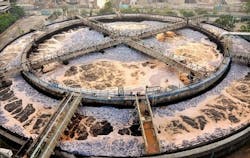The Green Treatment
The Green Common Effluent Treatment Plant (CETP) in Gujarat, India, treats the effluent generated by more than 680 industrial manufacturing plants in the Vatva Industrial Estate. Since its creation in the 1990s, the CETP has kept pace with upgrades to its original activated sludge-type biological process system, resulting in multiple ISO certifications and numerous prestigious environmental awards.
The Vatva Industrial Estate was established by Gujarat Industrial Development Corp. and is located southeast of Ahmedabad City in Gujarat, a western coastal area of India. Gandhi, the famous leader of Indian nationalism, was from this region.
The 680 member units manufacture textiles, pharmaceutical products, dyes, chemicals and other organics. Each member plant is required to arrange for pretreatment of effluent that is then conveyed through an internal collection system and conveyance to the CETP in a systematic manner.
Treatment Process
The CETP is a conventional treatment plant with primary and secondary treatment based on the activated sludge process. The influent flow is 4.227 million gal per day (mgd). Influent chemical oxygen demand (COD) is 3,000 mg/L; biological oxygen demand (BOD) is 1,200 mg/L and total suspended solids (TSS) is 600 mg/L.
The secondary treatment is accomplished in a circular aeration tank having a volume of 7.4 million gal and a water depth of 27.8 ft. A coarse bubble diffused system was originally installed for aeration.
Today, a medium-bubble diffused aeration system supplemented by 18-by-60-hp Triton process aerators supply air to maintain the desired dissolved oxygen (DO) level and also to maintain the MLSS in suspension. The organic matter is aerobically degraded by the microorganisms contained in the activated sludge. The various parameters including mixed liquor volatile suspended solids (MLVSS), mixed liquor suspended solids (MLSS), food to microorganisms ratio (F/M ratio), DO level and concentration of nutrients are closely monitored and maintained to achieve the maximum degradation of organics.
The system utilizes two secondary clarifiers. A portion of the activated sludge is recycled into the aeration basin while the remainder goes to a sludge holding tank and pumped to a centrifuge decanter for dewatering.
The final effluent is pumped to a mega pipeline for ultimate conveyance into river Sabarmati at Pirana after mixing with the treated sewage discharged from Pirana STP of Ahmedabad Municipal Corp.
Upgrade of Aeration System
In 2007, CETP upgraded its treatment plant to improve the biodegradation to maintain MLVSS levels at a desired value and to improve oxygen transfer efficiency by upgrading and augmenting its current systems.
CETP replaced the existing coarse-bubble diffuser aeration with a medium-bubble diffuser aeration system. Plant officials observed that using the entire quantity of required air through the aeration grids cause the air to heat, raising the temperature of the mixed liquor and thus, ultimately reducing solubility of oxygen and oxygen transfer efficiency.
Hence, CETP decided to use the grid system for the partial fulfillment of the aeration requirement and augment it with another type of system.
After carrying out a detailed survey and evaluation of different types of aeration systems, the Aire-O2 Triton process aerators manufactured and supplied by Aeration Industries Intl. were selected for augmenting the oxygen supply. A total of 18 aerators, each of 60 hp, were installed in the tank. Necessary bridges and columns were constructed to support these aerators.
The new combined aeration system maintains the desired DO level and also maintains the MLSS in suspension.
“We are very satisfied with the overall performance of the Triton aerators,” said Jatin Patel, general manager of operations. “We have observed many advantages of the aerators over the diffusers. Amongst them are high oxygen transfer and mixing at low power, low maintenance, low noise and low downtime.”
Patel said the biggest advantage of the Triton is that the aeration tank is “not required to be emptied out while carrying out maintenance on the aerators.”
The performance of the treatment plant in terms of COD and BOD concentrations in the final effluent is 800 to 1000 mg/L and 40 to 60 mg/L respectively, meeting environmental standards.
Awards
The achievement due to the implementation of the environmental infrastructure projects is meeting permit limits and preventing of water pollution. The industrial estate area has a clean and aesthetic look. CETP has gained numerous ISO certifications and was twice the recipient of both the Golden Peacock Environment Management Award and the Gold Award presented by the Greentech Foundation under Environmental Excellence.
Cheri Cohen is vice president, marketing, of Aeration Industires Intl. Cohen can be reached at [email protected].
